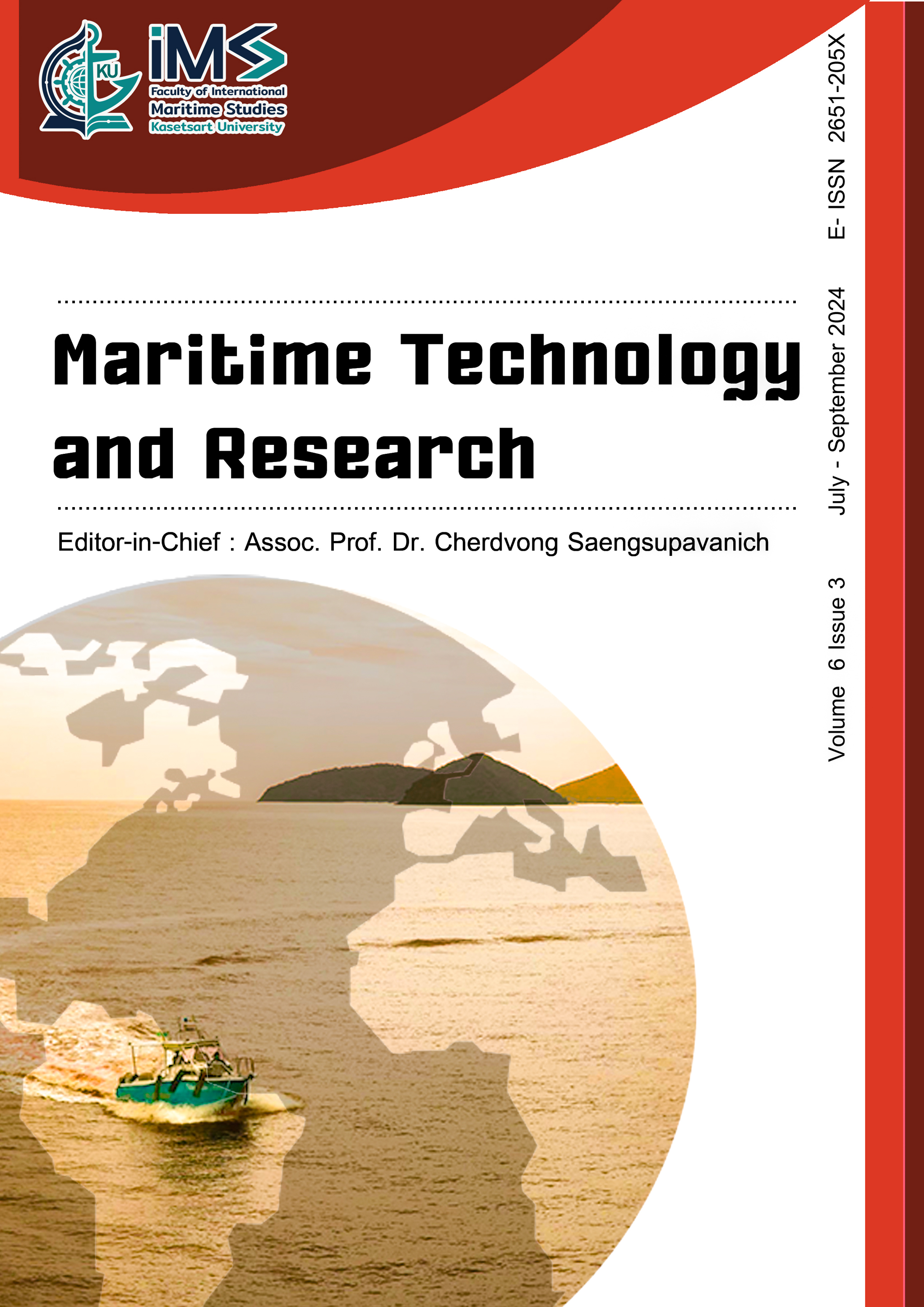Effects of a long-drive shaft on flow field around a high-speed boat propeller in Thailand using CFD
DOI:
https://doi.org/10.33175/mtr.2024.269212Keywords:
Long-Drive Shaft (LDS), Long-Tail Boat (LTB), Inclined Shaft Propeller, Reynolds Averaged Navier-Stokes (RANS), Computational Fluid Dynamics (CFD)Abstract
The Long-Tail Boat (LTB) is a high-speed boat in Thailand. The propulsive system has a long-drive shaft that holds the propeller on the end of the shaft. It is used under inclined shaft conditions because of shallow water draft. Thus, the fluid flow into the propeller blade area is unsteady due to the cross-flow component. Therefore, the long-drive shaft is an important parameter in generating the flow field before entering the propeller blades, which affects propeller efficiency. This paper presents a numerical analysis of the flow field around a long-drive shaft and propeller blade areas in a full-scale propeller size using the Reynolds-Averaged Navier-Stokes (RANS) solver. The unsteady propeller performance is carried out by considering inclined flow conditions. In addition, the computational results of fluid flow in terms of the pressure distributions and wake fields around a long-drive shaft and propeller are investigated, which influence the propeller performance and the generating drag forces by a long-drive shaft. The results can be applied to modify the long-drive shaft of boats.
------------------------------------------------------------------------------
Cite this article: Kaewkhiaw, P. (2024). Effects of a long-drive shaft on flow field around a high-speed boat propeller in Thailand using CFD. Maritime Technology and Research, 6(3), 269212. https://doi.org/10.33175/mtr.2024.269212
------------------------------------------------------------------------------
Highlights
- The Long-Tail Boat (LTB) is a local vessel in Thailand that has a high speed
- Computational fluid dynamics (CFD) code ANSYS Fluent to study the effect of a long-drive shaft propeller with inclined shaft angles
- The long-drive shaft should be designed in suitable for operating the inclined shaft conditions because it will directly affect the propeller efficiency
References
Abbasi, A.A., Franzosi, G., Canepa, E., Gaggero, S., Villa, D., Viviani, M., & Tani, G. (2023). Experimental analysis of the flow field around a propeller with inclined shaft. Ocean Engineering, 285, 115-237. https://doi.org/10.1016/j.oceaneng.2023.115237
Aktas, B., Atlar, M., Turkmen, S., Korkut, E., & Fitzsimmons, P. (2015). Systematic cavitation tunnel tests of a Propeller in uniform and inclined flow conditions as part of a round robin test campaign. Ocean Engineering, 120, 136-151. http://dx.doi.org/10.1016/j.oceaneng.2015.12.015
Alder, R. S., & Moore, D. H. (1977). Performance of an inclined shaft partially-submerged propeller operating over a range of shaft yaw single. David, W. (Ed.). Taylor Naval Ship Research and Development Center, Bethesda, Maryland, USA.
ANSYS Fluent Theory Guide. (2021). ANSYS.
ANSYS Fluent User’s Guide. (2021). ANSYS.
Efremov, D. (2021). Determining the loss of efficiency of twin propeller systems in circulation maneuvers. Maritime Technology and Research, 3(2), 89-101. https://doi.org/10.33175/mtr.2021.244703
Gaggero, S., & Villa, D. (2018). Cavitating propeller performance in inclined shaft conditions with OpenFOAM: PPTC 2015 Test Case. Journal of Marine Science and Application, 17, 1-20. https://doi.org/10.1007/s11804-018-0008-6
Kaewkhiaw, P. (2018). The effect of shaft yaw angles on propeller performance for Long-Tail Boat using CFD. In Proceedings of the 13th International Conference on Hydrodynamics, Incheon, Korea.
Kaewkhiaw, P. (2020). CFD analysis of unsteady propeller performance operating at different inclined shaft angles for LONG-TAIL boat in Thailand. Journal of Naval Architecture and Marine Engineering, 17(2), 115-127. http://dx.doi.org/10.3329/jname.v17i2.42622
Kaewkhiaw, P. (2021). Numerical study of propeller boss cap fins on propeller performance for Thai Long-Tail Boat. Ocean Systems Engineering, 11(4), 373-392. https://doi.org/10.12989/ose.2021.11.4.373
Kaewkhiaw, P., Yoshitake, A., Kanemaru, T., & Ando, J. (2015). Experimental and numerical study of propeller performance for Long-Tail Boat in Thailand. The Japan Society of Naval Architects and Ocean Engineers, 20, 407-410.
Ortolani, F., & Dubbioso, G. (2019). Experimental investigation of single blade and propeller loads by free running model test. Straight ahead sailing. Applied Ocean Research, 87, 111-129. https://doi.org/10.1016/j.apor.2019.03.005
Ortolani, F., & Dubbioso, G. (2019). Experimental investigation of blade and propeller loads: Steady turning motion. Applied Ocean Research, 91, 101874. https://doi.org/10.1016/j.apor.2019.101874
Ortolani, F., Capone, A., Dubbioso, G., Pereira, F. A., Maiocchi, A., & Felice, F. D. (2020). Propeller performance on a model ship in straight and steady drift motions from single blade loads and flow field measurements. Ocean Engineering, 197, 106881. https://doi.org/10.1016/j.oceaneng.2019.106881
Paik, K. J., Jang, Y. H., Eom, M. J., Kim, S. H. & Song, G. (2020). A numerical study on the open water performance of a propeller with sinusoidal pitch motion. Brodogradnja/Shipbuilding, 71(1), 71-83. http://dx.doi.org/10.21278/brod71105
Peck, J. G., & Moore, D. H. (1974). Inclined-shaft propeller performance characteristics. Report of SNAME, New York, USA.
Practical Guidelines for Ship CFD Applications. (2011). ITTC recommended procedures and guidelines.
Seyyedi, S. M., Shafaghat, R., & Siavoshian, M. (2019). Experimental study of immersion ratio and shaft inclination angle in the performance of a surface-piercing propeller. Mechanical Sciences, 10, 153-167. https://doi.org/10.5194/ms-10-153-2019
Soares, C. G., Tadros, M., & Ventura, M. (2022). An optimization procedure for propeller selection for different shaft inclinations. International Journal of Maritime Engineering, 164(A3), A295-A315. https://doi.org/10.5750/ijme.v164iA3.809
Taniguchi, K., Tanibayashi, H., & Chiba, N. (1969). Investigation into the propeller cavitation in oblique flow. Mitsubishi Technical Bulletin, Japan.
Wang, C., Sun, S., Sun., S., & Li, L. (2017). Numerical analysis of propeller exciting force in oblique flow. Journal of Marine Science and Technology, 22, 602-619. https://doi.org/10.1007/s00773-017-0431-4
Yao, J. (2015). Investigation on hydrodynamic performance of a marine propeller in oblique flow by RANS computations. International Journal of Naval Architecture and Ocean Engineering, 7, 56-69. http://dx.doi.org/10.1515/ijnaoe-2015-0005
Zheng, C., Hong, F., Zhang, Z., & Liu, D. (2022). The numerical investigation of propeller cavitation benchmark tests in oblique flow. In Proceedings of the 7th International Symposium on Marine Propulsors, Wuxi, China.
Downloads
Published
License
Copyright (c) 2024 Maritime Technology and Research

This work is licensed under a Creative Commons Attribution-NonCommercial-NoDerivatives 4.0 International License.
Copyright: CC BY-NC-ND 4.0








